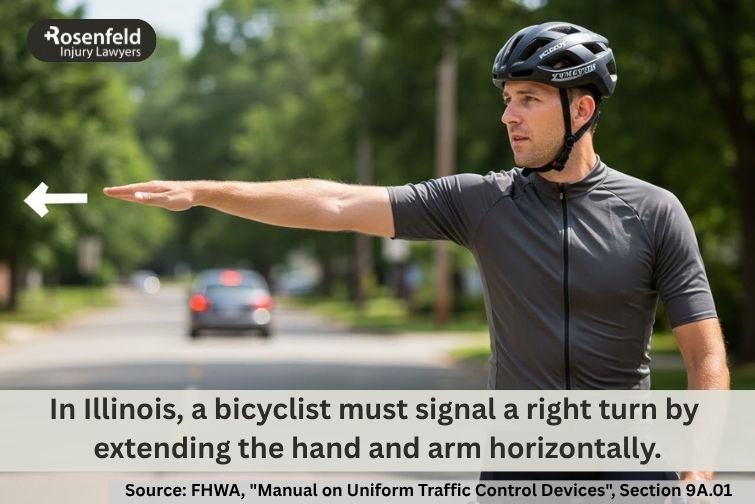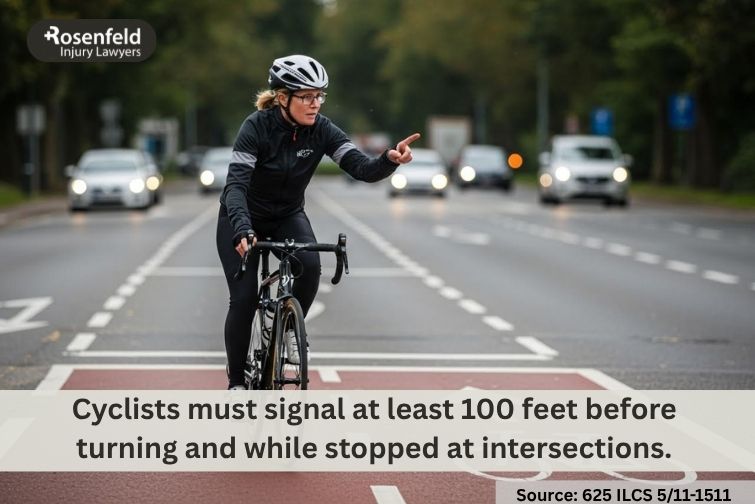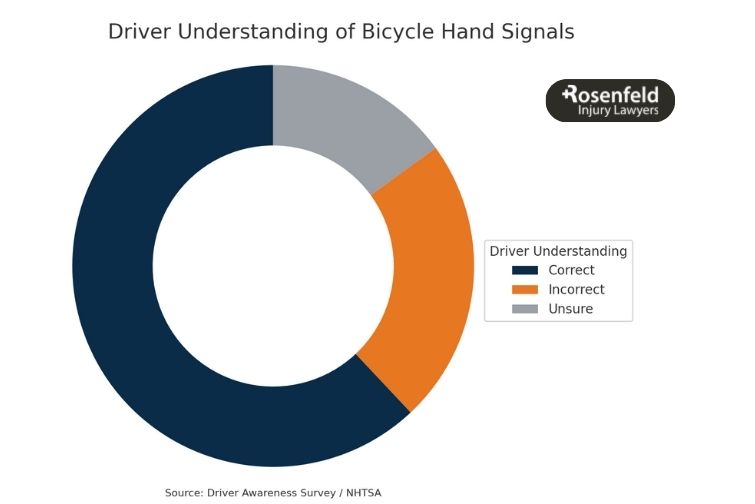Accident Lawyer
Bike Hand Signals
Although more bike lanes are being added to the infrastructure in Illinois cities, there are still some risks involved in operating a bicycle in proximity to other motor vehicles and pedestrians. A strategy to help you stay safe while riding is to use bike hand signals to inform those around you of your intentions.
Motorists already fail to watch out for bikers on the roads, but another issue is that drivers do not always know what a cyclist is planning to do. It is your responsibility as a cyclist to use basic bike hand signals to provide important information to the drivers around you.
A failure to communicate your movements could lead to liability if you cause an accident. Cyclists must follow the same rules of the road as motorists, which includes signaling right and left turns to others. Therefore, bike hand signals can keep you safe and protect you from liability in the event of an accident.
If you are injured in a bicycle accident in Illinois, you may be eligible for compensation to cover your legal damages. Chicago Bike Injury Lawyers will stand by your side and guide you through the claims process to fight for justice against the at-fault party.

What Are the Basic Bike Hand Signals?
If you plan to ride a bicycle on the roads, then you must learn the required bike hand signals in Illinois. Most of these hand signals can be made with the left arm and hand, but you can also use your right arm in specific circumstances.
Let’s look at some of the most important motions to signal to motorists, pedestrians, and other cyclists about your intentions while riding.
Left Turn Signal
Most of the basic bike hand signals are done with your left arm and hand. If you are preparing to make a left turn, you must stick your left arm and hand out horizontally to the left. Hold that position as long as you are able, only stopping to put both hands on the handlebars to maintain control of the bike.
Right Turn Signal
For a right turn, you will hold your left arm and hand up into the air in a vertical orientation. Again, try to make this signal for at least 100 feet in advance of the actual right turn. You can also signal this turn with an alternative method by extending your right arm and hand horizontally out to the right.
Stopping
Since there are no brake lights on a bike to indicate you are stopping, you must use your hands to signal. Extend your left arm out to the left and bend your elbow downward at a 90-degree angle with your hand flat. This will indicate that you intend to brake and come to a stop.
Slowing Down
You can also use bike hand signals to tell the vehicles around you that you are merely slowing down rather than stopping. This motion involves pointing your right or left arm down toward the road and waving your hand back and forth a little.
Overtake
There are many reasons why you may want a vehicle or fellow cyclist to overtake you, especially if there is an obstacle or you are going slower than they are. For this hand signal, hold your right or left arm downward toward the road with your palm open and wave your hand forward several times to let the person know they can pass you.
Road Hazard
Sometimes, riding a bicycle makes it easier to spot approaching road hazards, such as a pothole. You can use bike hand signals to let others know about the danger. You can simply point downward at the hazard as you ride by it, or you can point downward and move your hand in a small circling motion.
Merging or Taking the Lane
A left turn or right turn is not the same as a merge, so it requires a different hand signal. If you are switching lanes due to a hazard or approaching obstacle, or to make a turn up ahead, you should hold your left arm down and bend it slightly. It is similar to the hand signal for a normal left turn, but your arm should not be extended all the way; instead, it should be bent a little.
Thanking Someone
Although this hand signal is by no means required, it can make other cyclists and drivers appreciate you and give you more space. Lift your hand and give them a wave as they pass by. Cyclists often thank motorists for moving over, yielding, or driving cautiously near them.
Group Stopping
If you are riding with a group of other cyclists, you can communicate an upcoming stop for everyone by holding your hand high in the air with the palm facing forward. This ensures your fellow cyclists know about the intention to stop, while also warning approaching motorists of what the group will do.

How to Properly Use Hand Signals and Prevent Accidents
While using bike hand signals in isolation can make a huge difference for your safety, there are additional strategies that can make your ride even more comfortable.
Here are some additional tips for using bike hand signals that can help prevent dangerous accidents:
- Plan your route – Although many cyclists ride for pleasure, anticipating a route can make your life much easier. If you think about your route ahead of time, you can prepare for turns and the correct bike hand signals you will need throughout the ride.
- Check your surroundings – Even if you make all the appropriate bike hand signals, it is not a guarantee of your safety. Get into the practice of scanning your environment before, during, and after making a hand signal to ensure it is safe to follow through with a left turn or stop.
- Make your signals obvious – Confidence is key when prioritizing safety on the roads. If you are going to hold your hand forward or make a circling motion, make it as large a gesture as possible. If you are timid with your hand signals, other drivers may not notice your intention to change lanes, turn, or stop.
- Follow the three-second rule – While you should try to display your hand signal long enough to ensure other motorists notice it, you must still keep the bike steady. A good rule of thumb is to display your hand signal for at least three seconds.
- If possible, make eye contact – A bike hand signal should be sufficient to keep you safe when making a right turn or changing your speed. However, if you can make eye contact with the motorists around you when doing the hand signal, you will have a better chance of them noticing your intentions.
- Give ample warning – The distance at which you make your bike hand signal is just as important as the duration. You shouldn’t wait until the moment you are ready to turn before signaling to those around you. Instead, try to begin your bike hand signal roughly 100 feet before you take the indicated action.

How Do Hand Signals Impact Illinois Bicycle Accident Victims’ Rights?
The Illinois Vehicle Code requires all motorists to signal their intentions, including making turns or merging. Since bicyclists are required to follow the same laws as motorists, these standards still apply.
Under 625 ILCS 5/11-805, a driver is required to employ hand signals if they cannot make use of their turn signals for one reason or another. The hand signals in this scenario are the same as for bikers (left arm extended for a left turn, left arm bent upward for a right turn, and left arm bent downward for stopping).
A failure to communicate your intentions is a traffic violation for anyone operating a vehicle. Therefore, if you do not use bike hand signals and cause an accident, you may be liable for the victim’s legal damages.
One element that may play a role in liability is comparative negligence (735 ILCS 5/2-1116). According to this statute, fault can be shared among multiple parties who contributed to the injuries. You can only pursue compensation if you are no more than 50% at fault for the accident.
How an Experienced Bicycle Accident Lawyer Can Help
Our law firm believes in your case and will help you pursue justice against the negligent parties. If you were hit by a car after safely signaling a turn with your right arm, we will speak to witnesses and obtain surveillance footage to prove your innocence.
Our legal services include:
- Investigating the accident scene
- Gathering evidence
- Assessing all legal damages
- Negotiating with insurance companies
- Protecting your rights under Illinois and federal laws
- Litigating in civil court if necessary
- Working on a contingency fee basis (you pay nothing unless we win)
Cyclists can still face risks if they correctly employ bike hand signals. Our attorneys will fight for fair compensation on your behalf. Contact us today at 312-646-3708 to schedule a free consultation about your bicycle accident injuries.
Content reviewed by Chicago bicycle accident lawyer Jonathan Rosenfeld of Rosenfeld Injury Lawyers LLC, who holds negligent drivers, municipalities, and corporate defendants accountable to protect injured cyclists and their families, and is a trial lawyer recognized by National Trial Lawyers, Best Attorneys of America, and the National Association of Personal Injury Attorneys for high-severity injury claims.








